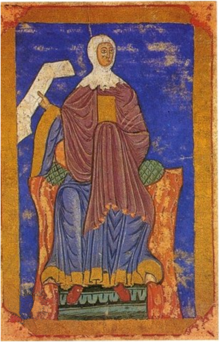Urraca of Zamora
Urraca von Zamora , also called Urraca von León or Urraca Fernández , (* 1033 in León ; † 1103 ) was a Spanish Infanta from the House of Jiménez in the 11th century.
She was the eldest of five children of King Ferdinand I of León-Castile and the Sancha of León . Her younger siblings were Sancho II , Elvira , Alfons VI. and García .
Life
Before his death in 1065, Ferdinand I had agreed to divide his sovereign territory among his children. While the sons had been given kingdoms, Elvira had received the city of Toro and Urraca the city of Zamora as their own dominions. Zamora was strategically important on the southern border of the Kingdom of León to the Muslim Al-Andalus . Soon after the death of their mother in 1067, the brothers began a power struggle over the entire inheritance of their father. Urraca took sides with Alfons VI. At first, however, Sancho II seemed to be able to decide the fight for himself by succeeding in 1072 in occupying both León and Galicia in quick succession. Only Urraca offered him resistance in Zamora, which is why he besieged the city that autumn. On October 7, 1072 he was killed in battle by a knight from Zamora.
The Castilian followers of Sanchos II in particular believed that Urraca was primarily responsible for her brother's death. The epitaph of his grave in Oña describes her as a "woman with a cruel soul" (femina mente dira) who conspired with a known traitor to murder her brother. As such it has entered the most famous work of Spanish folklore, the epic of El Cid , who was a standard bearer of Sancho II. According to this story, she had Sancho II killed because she was the closest Alfonso VI. wanted to help victory, as it actually happened.
Urraca was able to rule in Zamora under the suzerainty of Alfonso VI. continue and, with his approval, assumed the title of queen at an unknown point in time. In January 1073 she mediated for Alfonso VI. the meeting that he used to capture Garcías. It is unclear whether Urraca was privy to this ambush; in any case, she and Elvira attended García's funeral in León in 1090, dressed in “royal robes”. The last time Urraca appeared on November 13, 1103, when she made a donation to the abbot of the Infantado de Covarrubias . She must have died shortly afterwards. The epitaph of her grave in the Abbey of San Isidoro in León bears the inscription “Hic requiescit domina Urraca, regina de Zamora”.
Movie
In the US historical film El Cid (1961), the role of Urraca was played by the French actress Geneviève Page .
literature
- Susan Havens Caldwell: Urraca of Zamora and San Isidoro in León: Fulfillment of a Legacy. In: Woman's Art Journal. Vol. 7 (1986), pp. 19-25.
Remarks
- ↑ Historia Silense , ed. by Simon Barton and Richard Fletcher in: The World of El Cid: Chronicles of the Spanish Reconquest. Manchester University Press, 2000, §8, p. 30 and §81, p. 45. Chronicon Regum Legionensium , ed. by Simon Barton and Richard Fletcher in: The World of El Cid: Chronicles of the Spanish Reconquest. Manchester University Press, 2000, p. 81.
- ↑ Historia Silense , ed. by Simon Barton and Richard Fletcher in: The World of El Cid: Chronicles of the Spanish Reconquest. Manchester University Press, 2000, §10, pp. 31-32.
- ↑ See Caldwell, p. 21, note 23.
- ↑ Chronicon Compostellanum, ed. by Enríque Flórez in: España Sagrada. Vol. 20 (1765), p. 610.
- ↑ Historia Silense, ed. by Simon Barton and Richard Fletcher in: The World of El Cid: Chronicles of the Spanish Reconquest. Manchester University Press, 2000, §13, p. 34.
- ↑ Cartulario del Infantado de Covarrubias , ed. by Luciano Serrano in: Fuentes para la Historia de Castilla por los pp. benedictinos de silos. Vol. 2 (1907), No. 20, p. 50. The death of "Reyna Doña Urraca" was erroneously dated to 1101. See Anales Toledanos I, ed. by Enríque Flórez in: España Sagrada. Vol. 23 (1767), p. 386.
- ↑ See Caldwell, p. 21, note 21.
Web links
| personal data | |
|---|---|
| SURNAME | Urraca of Zamora |
| ALTERNATIVE NAMES | Doña Urraca of Zamora; Urraca of León; Urraca Fernández |
| BRIEF DESCRIPTION | Infanta of Castile, mistress of Zamora |
| DATE OF BIRTH | 1033 |
| PLACE OF BIRTH | Leon |
| DATE OF DEATH | 1103 |
